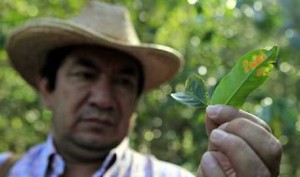Coffee leaf rust has caused serious losses in Central American coffee producing countries.
Coffee leaf rust, which begins to spread among coffee trees as small yellow spots, will soon turn coffee leaves into a pile of dead leaves.
In five years, the plague among coffee trees reduced coffee production in Central America to an all-time low, affecting not only the price of coffee, but also the labor balance in the region, forcing many local citizens to emigrate illegally to the United States.
Since 2012, when the fungus, known as "roya", was first discovered in Spain, it has spread to Guatemala, Panama and other countries.
Coffee production in the region has fallen by 20 per cent since 2011, with a total loss of more than US $1 billion, threatening more than 500000 jobs. Coffee accounts for 13.5 per cent of total export trade in the region, directly or indirectly providing jobs for 5 million people-10 per cent of the region's total population.
The U. S. government provided it with $14 million in aid, working with researchers in Texas to find a solution to fight the fungus.
"if the problem persists, employment and stability in the region will be threatened, which may affect local immigration patterns, and there will be more and more illegal immigrants to the United States," said Mark Feierstein, head of the U.S. Agency for International Development (USAID).
From 2011 to 2013, an estimated 255000 people lost their jobs as a result. The United States Agency for International Development predicts that coffee production could fall by 15 to 40 percent over the next two years. Coffee leaf rust destroyed coffee trees from Mexico to Peru, with Central American countries hardest hit.

El Salvador
According to the Central Bank of El Salvador, in previous years the country's coffee industry employed about 93000 Salvadorans, producing about 1.4 million bags (2011) a year. Coffee accounts for about 2 per cent of the country's gross domestic product (GDP).
Production impact: between 2011 and 2013, total coffee production fell by 378000 bags.
Job losses: 45000
Total losses: from 2011 to 2013, $61 million and 20 per cent decline in export earnings
Honduras
In previous years, the country's coffee industry employed 100000 Hondurans and produced about 6 million bags (2011) a year, according to the United Nations World Food Program. Coffee accounts for 7.3% of GDP.
Production impact: between 2011 and 2013, total coffee production fell by 1.3 million bags.
Job losses: 50000
Total losses: from 2012 to 2014, export revenues fell 45 per cent to $656 million.
Guatemala
According to the Guatemalan Ministry of Agriculture, in previous years, the Guatemalan coffee industry employed 500000 Guatemalans, producing an average of about 3.4 million bags (2011) per year. Coffee accounts for about 2.5% of GDP.
Production impact: production fell by 583000 bags between 2011 and 2013.
Job losses: 71000
Total losses: from 2011 to 2013, $547.4 million and export earnings fell by 42 per cent.
Nicaragua
According to the Central Bank of Nicaragua, in previous years, the Nicaraguan coffee industry employed 350000 Nicaraguans, with an average annual output of about 1.5 million bags (2011). Coffee accounts for 6.1% of GDP.
Production impact: production fell by 475000 bags between 2011 and 2013.
Job losses: 64000
Total losses: from 2011 to 2013, $172.3 million and export earnings fell 33 per cent.
Costa Rica
According to the Costa Rican Ministry of Agriculture, in previous years, the coffee industry employed 55000 Costa Ricans, producing an average of about 105000 bags (2011) per year. Coffee accounts for 1% of GDP.
Production impact: production fell by 71000 bags from 2011 to 2013
Job losses: 25000
Total losses: from 2011 to 2013, $110.5 million, a 28% drop in export earnings.
Important Notice :
前街咖啡 FrontStreet Coffee has moved to new addredd:
FrontStreet Coffee Address: 315,Donghua East Road,GuangZhou
Tel:020 38364473
- Prev

Introduction to the planting environment of coffee trees in Guatemala
The coffee planting base in Guatemala faces severe landscape changes and shrinking habitats, and more than 90 species of migratory birds have found refuge in shaded trees. In early autumn (north temperate zone), birds such as Nashville warbler (Vermivoraruficapilla), wide-winged eagle (Buteo swordfish), crested flycatcher (Myiarchuscrinitus), lovely summer Donna Finch (Piranga Waxberry), Raptors
- Next

The use of coffee grounds for growing mushrooms on coffee grounds
Coffee grounds, which are regarded as rubbish, have become fashionable and environmentally friendly products favored by some NGO, foreign enterprises and neighborhoods in Shanghai. It is mainly made of recycled coffee grounds and other natural ingredients and can grow mushrooms. If it is only this simple, how can it attract such grand attention? Its birth, its designed journey of life, and the meaning it has been given are all interesting and extraordinary. Grow mushrooms on coffee grounds
Related
- Beginners will see the "Coffee pull flower" guide!
- What is the difference between ice blog purified milk and ordinary milk coffee?
- Why is the Philippines the largest producer of crops in Liberia?
- For coffee extraction, should the fine powder be retained?
- How does extracted espresso fill pressed powder? How much strength does it take to press the powder?
- How to make jasmine cold extract coffee? Is the jasmine + latte good?
- Will this little toy really make the coffee taste better? How does Lily Drip affect coffee extraction?
- Will the action of slapping the filter cup also affect coffee extraction?
- What's the difference between powder-to-water ratio and powder-to-liquid ratio?
- What is the Ethiopian local species? What does it have to do with Heirloom native species?

